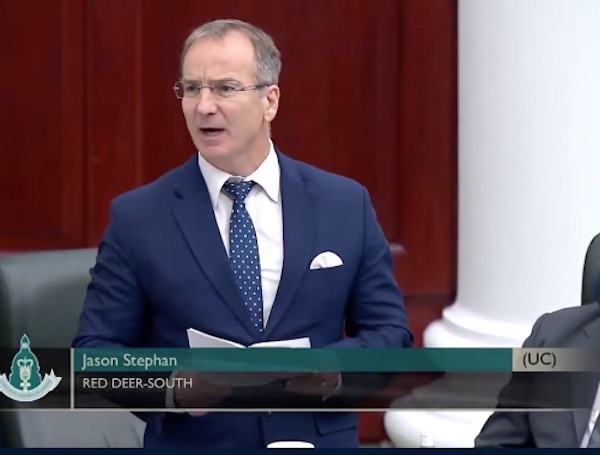Canadian Energy Centre
Unleashing Canada’s competitive advantage in energy and natural resources

From the Canadian Energy Centre
By Cody Ciona
Q&A with Bryan Detchou, senior director of natural resources, environment and sustainability with the Canadian Chamber of Commerce
Canada’s energy sector is one of the country’s greatest strengths, says an emerging leader with the Canadian Chamber of Commerce.
Bryan Detchou is the Chamber’s senior director of natural resources, environment and sustainability.
A former government relations consultant and staffer on Parliament Hill, in 2023 The Peak recognized Detchou as one of Canada’s young leaders shaping the country’s economy, culture and society.
The Chamber boasts a membership of over 200,000 businesses, including many energy-related companies. Detchou helps advocate for achieving the sector’s untapped potential.
Here’s what he shared with the Canadian Energy Centre:
CEC: Why does the Canadian Chamber of Commerce support Canada’s oil and natural gas sector?
BD: The mandate of the Canadian Chamber of Commerce is to support and be the leading voice for all businesses across the Canadian economy.
You cannot discuss the Canadian economy without recognizing the essential role of the oil and gas sector.
CEC: What role should Canada’s energy sector play in the 21st century Canadian and world economies?
BD: We believe that Canada’s energy and natural resources sectors are sources of pride and deserve strong support. These sectors hold the potential for Canada to exceed expectations on the global stage, positioning us as a key player in solving many of the world’s pressing challenges.
The conflict in Ukraine has exposed vulnerabilities in European and global energy security, underscoring the critical role Canada can play in addressing these issues. It is not only Canada’s responsibility to its citizens but also its duty to the global community to be a strong and reliable energy partner.
However, our failure to act decisively on energy security weakens our position and undermines our ability to contribute meaningfully to the reduction of global emissions.
CEC: How can Canadian energy businesses take a leadership position in emissions reduction?
BD: The majority of emissions reductions are being driven by the private sector, and we’re already seeing significant investments from various organizations. However, the challenge lies in the substantial capital required for these initiatives.
Before making major investment decisions, companies need a level of certainty and predictability in the markets they operate in—this is where the government can play a stronger role.
Regulatory hurdles, such as amendments to the Impact Assessment Act and the slow deployment of Investment Tax Credits, continue to create uncertainty.
We must understand that this is a global race. Canada is not the only country working to reduce greenhouse gas emissions and attract the necessary investment.
It is our responsibility to identify and leverage our competitive advantages. There is still much Canada can do to ensure its regulatory framework is conducive to attracting investment and driving environmental progress.
CEC: How is the federal greenwashing Bill C-59 impacting Canadian energy companies?
BD: From the outset, we have been fully engaged in addressing the challenges posed by this new legislation, starting with our involvement when the amendment was first introduced in the House of Commons committee in late May.
We testified before the Senate in early June, voicing the concerns of the industry, and have remained actively engaged ever since.
We unequivocally support the goal of ensuring that no Canadian company engages in deceptive marketing, whether in terms of product claims or the communication of their environmental commitments, particularly those aimed at combating climate change. Transparency and accountability are fundamental.
However, the law’s vague language and the absence of a clearly defined methodology have unfortunately created uncertainty across all sectors of the Canadian economy. This uncertainty hinders the ability of businesses to openly and confidently contribute to Canada’s ambitious climate goals.
Rather than driving environmental progress, the new law has inadvertently undermined the significant efforts already made by Canadian corporations, and by extension, the Canadian government. It has become a barrier to both innovation and meaningful environmental action.
The time has come for the government to revisit this legislation. The government should do now what it should have done in May and work collaboratively with industry stakeholders to develop a made-in-Canada regime that ensures corporate accountability and transparency while fostering, not stifling, innovation and environmental ambition.
Only by doing this can we achieve the climate objectives that Canada is striving for.
CEC: What does the Chamber believe are the best steps forward for Canada’s energy sector?
BD: The best way forward for Canada’s energy sector involves recognizing and leveraging our natural resources as one of the country’s greatest strengths, rather than a weakness. In the face of global challenges Canada’s energy sector must evolve to address these pressing issues.
We advocate for a balanced approach that includes diversifying the energy portfolio with investments in renewable technologies and innovations like carbon capture and storage and hydrogen, ensuring a clear and efficient regulatory framework to attract investment, and strengthening Indigenous partnerships to foster shared prosperity.
Promoting sustainable resource development to meet net-zero targets, expanding global market opportunities, and enhancing collaboration between government and industry are crucial.
By embracing our energy sector as a key asset, Canada can enhance its role on the global stage, support our allies, and combat climate change effectively. Unleashing the full potential of Canada’s natural resources is essential for securing energy security, achieving economic growth and driving long-term prosperity.
Alberta
‘Weird and wonderful’ wells are boosting oil production in Alberta and Saskatchewan

From the Canadian Energy Centre
Multilateral designs lift more energy with a smaller environmental footprint
A “weird and wonderful” drilling innovation in Alberta is helping producers tap more oil and gas at lower cost and with less environmental impact.
With names like fishbone, fan, comb-over and stingray, “multilateral” wells turn a single wellbore from the surface into multiple horizontal legs underground.
“They do look spectacular, and they are making quite a bit of money for small companies, so there’s a lot of interest from investors,” said Calin Dragoie, vice-president of geoscience with Calgary-based Chinook Consulting Services.
Dragoie, who has extensively studied the use of multilateral wells, said the technology takes horizontal drilling — which itself revolutionized oil and gas production — to the next level.
“It’s something that was not invented in Canada, but was perfected here. And it’s something that I think in the next few years will be exported as a technology to other parts of the world,” he said.
Dragoie’s research found that in 2015 less than 10 per cent of metres drilled in Western Canada came from multilateral wells. By last year, that share had climbed to nearly 60 per cent.
Royalty incentives in Alberta have accelerated the trend, and Saskatchewan has introduced similar policy.
Multilaterals first emerged alongside horizontal drilling in the late 1990s and early 2000s, Dragoie said. But today’s multilaterals are longer, more complex and more productive.
The main play is in Alberta’s Marten Hills region, where producers are using multilaterals to produce shallow heavy oil.
Today’s average multilateral has about 7.5 horizontal legs from a single surface location, up from four or six just a few years ago, Dragoie said.
One record-setting well in Alberta drilled by Tamarack Valley Energy in 2023 features 11 legs stretching two miles each, for a total subsurface reach of 33 kilometres — the longest well in Canada.
By accessing large volumes of oil and gas from a single surface pad, multilaterals reduce land impact by a factor of five to ten compared to conventional wells, he said.
The designs save money by skipping casing strings and cement in each leg, and production is amplified as a result of increased reservoir contact.
Here are examples of multilateral well design. Images courtesy Chinook Consulting Services.
Parallel
Fishbone
Fan
Waffle
Stingray
Frankenwells
Alberta
How economic corridors could shape a stronger Canadian future

Ship containers are stacked at the Panama Canal Balboa port in Panama City, Saturday, Sept. 20, 2025. The Panama Canals is one of the most significant trade infrastructure projects ever built. CP Images photo
From the Canadian Energy Centre
Q&A with Gary Mar, CEO of the Canada West Foundation
Building a stronger Canadian economy depends as much on how we move goods as on what we produce.
Gary Mar, CEO of the Canada West Foundation, says economic corridors — the networks that connect producers, ports and markets — are central to the nation-building projects Canada hopes to realize.
He spoke with CEC about how these corridors work and what needs to change to make more of them a reality.
CEC: What is an economic corridor, and how does it function?
Gary Mar: An economic corridor is a major artery connecting economic actors within a larger system.
Consider the road, rail and pipeline infrastructure connecting B.C. to the rest of Western Canada. This infrastructure is an important economic corridor facilitating the movement of goods, services and people within the country, but it’s also part of the economic corridor connecting western producers and Asian markets.
Economic corridors primarily consist of physical infrastructure and often combine different modes of transportation and facilities to assist the movement of many kinds of goods.
They also include social infrastructure such as policies that facilitate the easy movement of goods like trade agreements and standardized truck weights.
The fundamental purpose of an economic corridor is to make it easier to transport goods. Ultimately, if you can’t move it, you can’t sell it. And if you can’t sell it, you can’t grow your economy.
CEC: Which resources make the strongest case for transport through economic corridors, and why?
Gary Mar: Economic corridors usually move many different types of goods.
Bulk commodities are particularly dependent on economic corridors because of the large volumes that need to be transported.
Some of Canada’s most valuable commodities include oil and gas, agricultural commodities such as wheat and canola, and minerals such as potash.
CEC: How are the benefits of an economic corridor measured?
Gary Mar: The benefits of economic corridors are often measured via trade flows.
For example, the upcoming Roberts Bank Terminal 2 in the Port of Vancouver will increase container trade capacity on Canada’s west coast by more than 30 per cent, enabling the trade of $100 billion in goods annually, primarily to Asian markets.
Corridors can also help make Canadian goods more competitive, increasing profits and market share across numerous industries. Corridors can also decrease the costs of imported goods for Canadian consumers.
For example, after the completion of the Trans Mountain Expansion in May 2024 the price differential between Western Canada Select and West Texas Intermediate narrowed by about US$8 per barrel in part due to increased competition for Canadian oil.
This boosted total industry profits by about 10 per cent, and increased corporate tax revenues to provincial and federal governments by about $3 billion in the pipeline’s first year of operation.
CEC: Where are the most successful examples of these around the world?
Gary Mar: That depends how you define success. The economic corridors transporting the highest value of goods are those used by global superpowers, such as the NAFTA highway that facilitates trade across Canada, the United States and Mexico.
The Suez and Panama canals are two of the most significant trade infrastructure projects ever built, facilitating 12 per cent and five per cent of global trade, respectively. Their success is based on their unique geography.
Canada’s Asia-Pacific Gateway, a coordinated system of ports, rail lines, roads, and border crossings, primarily in B.C., was a highly successful initiative that contributed to a 48 per cent increase in merchandise trade with Asia from $44 million in 2006 to $65 million in 2015.
China’s Belt and Road initiative to develop trade infrastructure in other countries is already transforming global trade. But the project is as much about extending Chinese influence as it is about delivering economic returns.

Piles of coal awaiting export and gantry cranes used to load and unload containers onto and from cargo ships are seen at Deltaport, in Tsawwassen, B.C., on Monday, September 9, 2024. CP Images photo
CEC: What would need to change in Canada in terms of legislation or regulation to make more economic corridors a reality?
Gary Mar: A major regulatory component of economic corridors is eliminating trade barriers.
The federal Free Trade and Labour Mobility in Canada Act is a good start, but more needs to be done at the provincial level to facilitate more internal trade.
Other barriers require coordinated regulatory action, such as harmonizing weight restrictions and road bans to streamline trucking.
By taking a systems-level perspective – convening a national forum where Canadian governments consistently engage on supply chains and trade corridors – we can identify bottlenecks and friction points in our existing transportation networks, and which investments would deliver the greatest return on investment.
-

 Alberta1 day ago
Alberta1 day agoPremier Smith explains how private clinics will be introduced in Alberta
-

 Alberta1 day ago
Alberta1 day agoAlberta introducing dual practice health care model to increase options and shorten wait times while promising protection for publicly funded services
-

 Business1 day ago
Business1 day agoUS Supreme Court may end ‘emergency’ tariffs, but that won’t stop the President
-

 Aristotle Foundation22 hours ago
Aristotle Foundation22 hours agoWe’re all “settlers”
-

 Indigenous17 hours ago
Indigenous17 hours agoIndigenous activist wins landmark court ruling for financial transparency
-

 Alberta17 hours ago
Alberta17 hours agoRed Deer’s Jason Stephan calls for citizen-led referendum on late-term abortion ban in Alberta
-

 Health1 day ago
Health1 day agoMore than 200 children will receive dangerous puberty blockers for new UK study
-

 espionage17 hours ago
espionage17 hours agoSoros family has been working with State Department for 50 years, WikiLeaks shows












